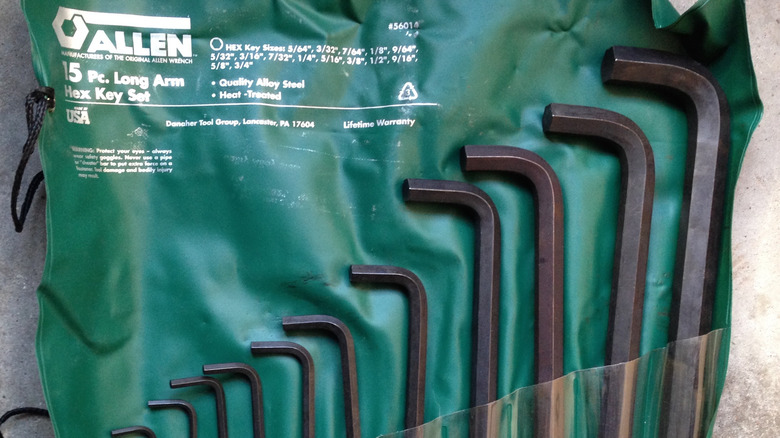Is There A Difference Between A Hex And An Allen Wrench?
This is a story about language more than it is a story about tools.
These days, hex wrenches — an essential tool for any DIYer, and part of any new home or apartment's basic toolkit — have migrated from being decent tools made by the Allen Manufacturing Company for use in their patented "Allen safety set screws," to now being decent tools made by just about every tool manufacturer. Furthermore, they've been commoditized to the extent that assemblies often come with a compatible hex wrench thrown in for free (think every IKEA product ever made). Still, you may be wondering if there is a technical difference between a hex and an Allen wrench — and if so, what is it?
Well, long story short, Allen Manufacturing Company advertised the screws and became associated with the wrench, but there's no fundamental difference between an Allen wrench and any other hex wrench of the time, and whatever distinction there may have once been has long since been dissolved by the vagaries of word usage, brand acquisitions, and trademark law. Perhaps this is more a story about the march of time than about language. What matters is that whether you say "Allen wrench" or "hex wrench," the person you're talking to will know what you mean. That said, here's a deeper look into the various name complications.
The death and immortality of the unpatented Allen wrench
If it weren't so pedantic, one could argue that hex and Allen wrenches are, in fact, distinguishable from each other in that one is a generic term for a tool and the other is a tool made by a specific company. Really, though, the term "Allen wrench" is little more than an accident of tool history. There was nothing new or innovative about Allen's version, and the tool was something of an afterthought.
Allen patented a process for making set screws, not hex wrenches, which were already an established tool by the time they gained the Allen name; set screws, or grub screws, are sometimes hard-to-remove fasteners inset into a threaded part to hole firmly to an unthreaded part. Technically, there is no longer any such thing as an Allen wrench, since the Allen name is no longer in use by its owner, the maker of Crescent wrenches (another tool in dire danger of genericide).
If this seems sad for some reason, consider the fact that William G. Allen had left the Allen Manufacturing Company by 1921 anyway, and the band has since been purchased by a company that no longer considers it important enough to even mention on its website... besides which, he didn't invent the blasted thing in the first place, as they had been in use since the 1860s. Yet his name lives on as an equivalent of "hex wrench," though one can't imagine why even Allen himself would care.
What's in a trademark?
"Allen wrench" is often described as being a victim of genericide... a peculiar legal term that's both imprecise and unintentionally, darkly funny. It is a portmanteau of "generic" and a combining form, "-cide," meaning something like "to kill." It would seem to describe the killing of a generic thing, but instead means the opposite: The destruction of a brand by making its name equivalent to the generic, such that people use said brand name for generic knockoff products (think how any paper tissue is a "Kleenex," or any tablet an "iPad"). Here's the thing, though. "Allen wrench" was never a trademark, though a particular logo including the Allen name and a wrench was trademarked. In fact, a previous owner had trademarked "the Allen wrench people" (now expired) but specifically excluded "Allen wrench" from any trademark claim. Confused yet?
It doesn't help the confusion that terms like patent and trademark are often used without any regard for their actual meanings, such as when people call the Allen wrench the first "trademarked hex key." You can no more trademark a hex key than copyright one. And by no longer making anything that uses the Allen wrench logo, the current owner of that brand (Apex Brands, Inc.) might eventually lose any claim to the name or the logo, since active use is a requirement of trademark protection.


